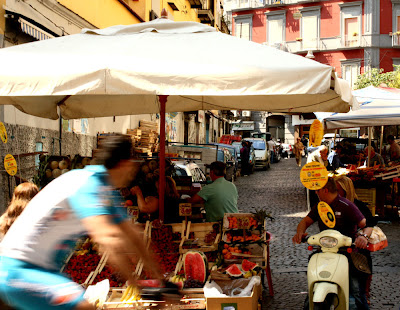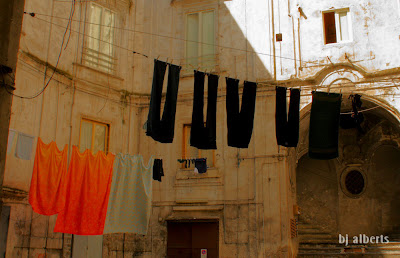As chaotic as it seems, here in Napoli things run on a fairly rigid time schedule and after you live here a while, you tend to fall right in. Up by 8 a.m., either by habit or the noise on the street pushing you out of bed, one starts the day with caffe. Kimbo caffe and a Bialetti espresso maker become your best morning friends. Add a few cornetti and you have the classic Neapolitan breakfast.
Next, we make short work of the dishes (by hand of course - no dishwashers in this apartment except for me), make the bed, throw on some clothes and we're out the door to do our daily shopping. We learned early on that its best to shop daily and that the earlier you get out, the better selection you'll find. Neapolitan store owners know exactly how much to stock. Get there late and they are liable to have run out, especially when it comes to bread and fresh fruits and vegetables.
All the negozzi (small stores) in our neighborhood are local. No supermarkets to really speak of. There is one down the hill, a CONAD, but even that's the size of a 7-11 in the States. The stores generally open their doors around 8:30 a.m., close for pausa around 2:30 p.m. and re-open again from around 5:00 p.m. until 8:30 p.m.
We start at Salumeria Buono, our neighborhood grocer if you will. The word salumeria translates to delicatessen, but it is so much more. The deli case is filled with the finest prosciuttos in Italy - crudo and cotto; speck, pancetta and mortadella - the original Bologna; the best salamis, Milanese and Napoletano of course; the all important parmeggiano-reggiano and a variety of other cheeses; and tubs filled with all types of olives. Mozzarella di Bufala, big white balls float in huge bowls of water on top of the deli case. Hard, crusty breads spill out of the bins behind. But that's only half the story, because the Salumeria also carries most of the essentials like olive oil and vinegar, pastas and rice, flour and sugar, milk and butter, sweets, and much more. And if we are too lazy to go to the Enoteca (wine store) or Panificio (bread store) down the road, we grab our wine, beer and bread here as well .
Walking into the Salumeria you immediately sense the difference between shopping here and in the States or the UK. A family run operation like all of the stores in our neighborhood, Ricardo and his son Salvatore are manning the deli counter while Rosa is minding the cash register, her new grandson Antonio on her knee. People are catching up on news, eating hunks of bread or cheese, and if it's a holiday season, you just might get offered a glass champagne or some other confection to celebrate the season. More of a social event than a shopping trip, the buying of merchandise is really secondary to catching up with family and friends.
Making our way up the sidewalk we say Buon Giorno to Antonio. The father of three and grandfather of five, including his namesake, Antonio from the Salumeria, he is in the pub cleaning up from the night before and getting ready for lunch service. A family operation in every sense of the word, everyone helps out. Antonio's wife makes all of the fresh contorni (vegetables and side dishes), his son-in-law cooks in the evening and his daughter and sons do everything else. Even his son's father-in-law helps out by cooking the daily lunch menu - your choice of two pasta dishes, a drink and bread for €5,00. We'll definitely be back for that!
Next stop is Bottega del Pollo da Carlo, our neighborhood Polleria (chicken butcher). A tiny shop filled with the freshest poultry, Carlo took over the polleria from his father many, many years ago, and he will soon pass it on to his son Massimiliano. His rotisserie sits just outside his store luring customers in with the wonderful aromas of roasted chicken.
Inside, his meat case is loaded with whole chickens and rabbits, chicken parts, pork loin, and sausages. Fresh eggs are stacked to the ceiling on the shelves nearby. We've known Carlo and his wife Claudia since the day we moved here and can always count on their friendship. We can also always count on him to make our second caffe of the day. Taking a seat on the small step ladder inside his shop, we sip our caffe and catch up on all the news of the day.
Next door is Mario's. Mario runs the Fruttivendolo (fruit and vegetable store) and a little Salumeria of his own with his wife and three kids. Fresh vegetables and fruits are why we're here and Mario doesn't disappoint. Overflowing green crates that climb the walls outside of his store are filled with the freshest produce - cherry and Sorrentine tomatoes, eggplants and zucchini, crisp green lettuces, red and yellow peppers, lemons and oranges, and the best fruits of the season. Mario sells seasonal produce only, so you don't want to be asking him for melons in November, but he and his wife are always happy to offer tips on how to prepare their produce, Neapolitan style of course.
Walking across the piazza we run into other friends from the neighborhood. The morning shop is a way to let everyone know that you're OK, all is well (or not well) with your family, whether you're working or not, and generally saying hello and wishing others well in our small piece of the city.
A "quick" stop in the Farmacia (pharmacy) comes next to pick up a prescription, then its off to the Tabaccheria (tobacco shop) next door. More a catch-all store than a tobacco shop, they carry pretty much everything else you need: bus tickets and lotto tickets, cleaning products and sundry items, copier and fax services, birthday gifts, and of course, tobacco.Your one-stop shop. I walked in here the other day and after a big order including my monthly bus tickets, I found myself €18,00 short. Not only did Antonio tell me to pay him later, but he reached in the till and offered me €50,00 back so I wouldn't be out of cash. When is the last time that happened to you? Only in Napoli.
Walking through the crowd in front of Gelateria Bilancioni (for unbelievably great gelato) our last stop is at the Macelleria (butcher). A side of beef and half a pig hang in the glass reefer and fresh cuts of beef, veal and pork fill his display cases. Both the macelleria and polleria have few pre-butchered products so if you want to make a veal scallopini that night, he will slice it (and pound it) to order. No need to buy a pound or 1/2 a pound - just tell him how many slices you want and that is what you'll get - even if you only want one. Bruno works with his son Gianni and is a Neapolitan history buff who loves to regale us with stories, this time, the tales of the Kingdom of the Two Sicilies.
Our morning shop and stroll is done. We covered no more than 300 meters in just less than 2 hours. We've caught up with our friends and our neighbors. Now I'm getting hungry for lunch. What's the pub serving today?





























